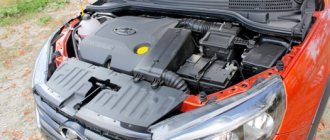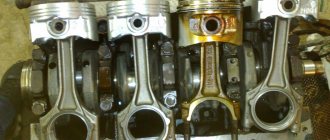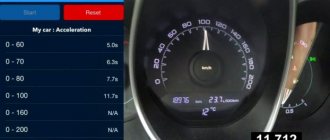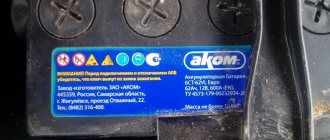What is the most important thing in a car? Wheels, interior, and maybe suspension - We believe that when choosing a car, everything is important. But the engine is the most important factor when deciding to buy a car. The Lada Vesta is powered by 3 modern engines from AvtoVAZ. Any car enthusiast would be curious to know in detail about each of them.
In total, the review material will consider three main types of engine:
— engine 21129 from VAZ — technical problems, characteristics; — 21179 from VAZ — the new top-end 1.8 engine is installed on the latest modifications, including the Lada Vesta SW Cross; The HR16DE-H4M propulsion system from Nissan is a chain motor with an impressive resource, but manual valve adjustment.
- What engine is installed on the Lada Vesta
- Motor VAZ 21129
- Motor VAZ 21179
- Engine Renault-Nissan H4M-HR16 DE
- Lada Vesta engine life - you need to know
- Subtle Features
What engine is installed on the Lada Vesta
The main engines for the Lada Vesta, which are installed by the manufacturer, are already indicated in the introduction. The company's decision to refuse to install the VAZ-11189 engine in the basic configuration was a winner. It seriously idles even on Grant and Priora; in fact, it is a modification of the VAZ-11186 model known to many. The only difference is that it has different intake and exhaust valves. The decision is due to the heavier body of the new car and increased requirements for the driving characteristics of the installed engine. There are three types of installations with different characteristics installed on cars. Two with a volume of 1.6 liters. and one 1.8 l. At 21179 AvtoVAZ had to increase engine power by 14 horses, without increasing appetite.
While writing this review, they traveled thousands of kilometers and we are ready to talk about the results. Recently, a wave of discussions was caused by the fact that one of the engines was not developed by VAZ, but will be supplied by Japanese manufacturers. Moreover, instead of the usual timing belt, it has a chain and it has more power. This allows you to seriously increase the power output of the motor. Is a chain better than a good engine belt?
Installation of alternative engines on Vesta
Equipping the Lada Vesta with other engines is not yet widespread. This car has not yet become a cult car, like, for example, the Lada Priora. There is no detailed information about how and what power plants can be installed instead of the standard ones. This topic remains at the theoretical level for now. Basically, as the most affordable method, it is proposed to install a turbine; moreover, this is the most budgetary tuning option that can increase power and dynamic characteristics without the need to completely replace the engine. The design features of Vesta are similar to Lada Priora, so theoretically it is possible to install different engines, for example, from Mazda, Honda, or Ford Focus. If everything is more or less clear with the choice, many nuances should be taken into account when making such substitutions:
- Installing an alternative motor will require much more financial investment than the same procedure with installing a standard unit.
- If you have the opportunity to buy a higher-class car, it is better to buy it than to spend even more on installing an engine under the hood of a budget car.
- Replacing the motor will require replacing the brake system and other elements.
- The project requires not only financial investments, but also a lot of free time.
- Without the appropriate knowledge, skills and experience, the project is doomed to failure.
- One cannot cope with such work alone.
Engines on Lada Vesta satisfy any requirements of motorists. In fact, for the first time, a Lada car receives a whole line of power units from the weakest to the most powerful; a foreign-made unit has appeared. Engineers also announce the possibility of installing a diesel engine, but when this will happen is unknown. The diesel engine is more economical, which means it will be very popular in Russia. This will be the first diesel engine in the history of AvtoVAZ.
We recommend reading:
- Does a Lada Vesta car owner really need car chip tuning and which one?
- Modern Lada Vesta or modernized Renault Logan?
- The domestic Lada Vesta car still needs rear mudguards
- Selecting and changing oil on Lada Vesta
- Gearbox for Lada Vesta: structural features and repairs
- Lada Vesta bumper: methods of dismantling and increasing protection of parts
Motor VAZ 21129
Let's talk about the first of two Russian models. There are quite a few differences between the 129 engine and the 127 Priorovsky, the youngest in the model range. In comparison with the VAZ-11186 engine, with a volume of 1.6 liters, it has a power of 106 horsepower. This difference is due to 16 valves instead of 8 in the previous version. Ambient temperature sensors and absolute pressure sensors are installed as standard. Characteristics of this Lada Vesta engine.
Power - 106 horsepower, spins up to 5800 rpm. Volume - 1.6 l. A highly modernized engine mount has been installed. Drive and timing type: standard DOHC timing belt. Torque characteristics - 148\4200. Motor weight - 109.2 kg. Cast iron cylinder block Electronic ignition system controlled by a processor. Adds dynamics to the car. Fuel type is unleaded gasoline with an octane rating of 95, but 92 is also possible. Power supply is via a distributed injection system. The car will accelerate to 100 km/h from 21129 in 12.8 seconds. With a 129 engine, Vesta consumes gasoline: in the city - 10.2 liters, mixed driving - 7.5 liters, on the highway - 6.2 liters.
Toxicity is at a level characteristic of the Euro 5 standard.
The running life is set at 200 thousand km.
Innovations compared to the design of the previous model monitor the quality of fuel, and do not idle. The damper system regulates the air supply at different speeds, which gives traction to the engine from the bottom and at the top.
Changes in the design of the 129 motor, facilitating long-term operation:
— a cylinder block with increased rigidity is installed, and other engine systems are improved. Compared to previous models, it shows an increase in quality indicators and meets European quality standards;
— the piston has one oil scraper ring and two thin compression rings, which reduces loss of performance due to friction;
— extensive opportunities for improving the power unit, tuning increases power to 145-150 hp.
The only noticeable drawbacks of the 129 engine are the high, uneven tone noise level. It may appear after prolonged use and at the very beginning. When the timing belt breaks, like most VAZ engines, it suffers from the fact that the valves bend.
Motor H4M
This is a joint development between Nissan and Renault. Nissan calls the engine HR16DE , and Renault calls it H4M . AvtoVAZ also uses the name from Renault. Main characteristics:
- fuel - gasoline;
- volume – 1.6 liters;
- power – 113 forces;
- torque – 152 Nm.
The gearbox is a Japanese-made JF015E from Jato. Among the features of the motor relative to Russian engines, the following main points can be highlighted:
- timing chain drive;
- aluminum cylinder block;
- solid cast iron sleeves.
With proper maintenance, the engine will last 250 thousand. This engine is quite popular and has mostly positive user ratings. Its main disadvantage is that its maintenance will cost more than engines from VAZ.
Motor VAZ 21179
This engine option was the first in the line with a volume of 1.8 liters. produced since 2016. Externally similar to competitors, but inside there are a lot of design features characteristic of the 179 model. Vesta with a 1.8 liter engine installed 21179. is much more dynamic and powerful than his less productive colleagues.
Characteristics of 21179 engine:
Power - 122 horsepower, spins up to 6050 rpm. The most powerful of our line. Volume - 1.8 l. It is assembled using a selective conveyor method. Drive and timing type - a German device from INA is installed for tensioning a toothed belt. The belt will need to be replaced after about 90 thousand km. Torque characteristics - 170/3750. Motor weight - 110.1 kg. Higher than competitors, but the difference is not noticeable. Block material is cast iron. Electronic ignition system controlled by a processor. The fuel used is similar to the previous version, AI-95 gasoline. Using a 179 engine, the car will accelerate to 100 km/h in 12 seconds. Fuel consumption: in the city - 10 l, mixed type of movement - 8 l, on the highway - 7 l. Toxicity - Euro5. No different from others, despite significantly different parameters. The running life is set at 300 thousand km, which significantly exceeds that of the 129 model.
As advantages of the engine, we note the following: - The 179 engine is installed on the long-awaited Lada Vesta Cross by many car enthusiasts. The power and driving characteristics are enough to not have any problems driving; — fast and confident driving and start from traffic lights;
— design feature for changing gas distribution phases; — lightweight and enlarged intake (31 mm) and exhaust (28 mm) valves were used; — standard AMT VAZ transmission is used. Some of the components were not made in Russia, but were manufactured by leading automakers. For example, the valves are made by Mahle, and the oxygen sensor is made by Bosch.
The disadvantages of the engine are higher fuel and oil consumption compared to the other two power plants. Valve bending (like other options in the line), resulting in a high noise level when operating in any gear. The last circumstance is typical for engines installed in Lada Vesta.
Reliability, weaknesses, maintainability
Reliability
The reliability of the engine is eloquently evidenced by the fact that the resource declared by the manufacturer is almost doubled. According to reports from car owners, there are engines with mileage of more than 350 thousand km without any significant repairs.
All car enthusiasts unanimously claim that with timely and high-quality maintenance, the VAZ-21129 is reliable and economical. You can read about this many times in the reviews of participants in various specialized forums.
For example, VADIM writes: “...1.6 engine mileage 83,500 km. Fuel consumption: city 6.5 - 7.0, highway 5.5 -6.0. Depends on the speed, quality of gasoline, and also on the build quality of the engine itself. There is no oil consumption, no topping up from replacement to replacement.”
Roman has the same opinion. He reports: “... I drive a Largus Cross 5 seats, I bought it at the dealership in June 2022, the mileage is 40 thousand km, the oil in the Lada Ultra engine is 5w40, I try to change it every 7000, during this time I don’t notice waste, oil consumption, from outsiders noise - the hydraulic compensators are knocking, and even then, in the first three or four seconds after starting in frost of -20, I don’t consider this critical, the engine is familiar from the Priora, it loves speed and does not consume much fuel.” Alexey adds: “...an excellent engine, it pulls well from low to low on the highway, low consumption of 5.7 liters!”
Well, those car owners who ignore timely maintenance, skimp on technical fluids, and really abuse the engine, can only sympathize.
As an example, the bewilderment of Soar Angele: “...Vesta 2022 mileage 135t km engine 21129 chip tuning done, forward flow on 51 pipes, tires R16/205/50 holder. There was a consumption of 10 liters in urban style, then suddenly the consumption increased to 15 liters per 100...”
Or like this. Razrtshitele from Vologda wrote the following opus: “... about engine speeds: the problem is that when the car is rolling at a speed of 5 km/h, it is difficult to get into 1st gear, but it’s easy to get into second gear. You stick it in, try to drive and drive with tension...”
For what??? Why stick into first gear if the car is already moving? To check the reliability of the engine and transmission? Comments, as they say, are unnecessary.
Issues of internal combustion engine reliability are constantly in the field of view of the manufacturer. Thus, in August 2022, the piston group was modified. The result was the elimination of the phenomenon of bending of valves when they come into contact with the piston.
Conclusion: The VAZ-21129 is a completely reliable engine if treated appropriately.
Weak spots
They are available on the VAZ-21129, but it must immediately be emphasized that they are not critical.
Complaints about the operation of the cooling system are caused by a poor-quality thermostat.
The main culprit for overheating is the thermostat.
There is some truth in this. It happens that the thermostat stops working, which can cause the engine to overheat. Or vice versa, it takes too long to warm it up to operating temperature. Both are bad.
In the first case, there is almost a 100% prerequisite for a major overhaul; in the second, prolonged but increased wear of the rubbing surfaces of the CPG will lead to the same result. There is only one way to solve the problem - to detect the malfunction in time and immediately take measures to eliminate it.
Timing drive. The operating life of the drive belt is set by the manufacturer at 200 thousand km. According to reviews, the figure is real and is maintained. The same cannot be said about the idler pulley and water pump. They usually fail by 120-140 thousand km, jam, and cause the drive belt to break.
The result is bent valves and a major overhaul of the engine. To prevent this from happening, it is necessary to change the timing components before the appointed time (90-100 thousand km).
The phenomenon of engine tripping brings a lot of trouble to car owners. In most cases, the cause is faulty spark plugs or ignition coils, or dirty injectors. Electrical parts need to be replaced, and injectors need to be washed.
Sometimes car enthusiasts are alarmed by loud knocking noises from under the hood. As a rule, their “authors” are hydraulic compensators, which quickly wear out when using low-quality oil.
Considering that hydraulic compensators cannot be repaired, they will have to be replaced. If the warranty period of the internal combustion engine has not expired, it is under warranty, free of charge. Otherwise, be prepared to shell out some cash. This will be a reason to calculate what to save on. Engine oil or repair.
As we can see, in most cases, engine weaknesses are caused by car owners themselves with their careless attitude towards the engine.
Engine Renault-Nissan H4M-HR16 DE
This engine, produced by the joint company Renault and Nissan, is not equipped with a timing belt. A chain is installed instead. You can save quite a lot on consumables, their purchase and replacement. After all, a good belt complete with rollers costs from 4,500 rubles. Let's talk about the main characteristics of the unit:
Power - 114 horsepower. Volume - 1.6 liters, like the 21129 engine. Type of drive and timing - instead of a timing belt, as previously written, there is a chain. The only drawback is the moment, there are no hydraulic compensators in the design, which means approximately every 100 thousand km. mileage will require valve clearance monitoring. Like 2109 in 2018! Torque characteristics - 153/4400 Motor weight - 109.1 kg. Cylinder block material is aluminum. Electronic ignition system controlled by a processor. Fuel types - AI-92, AI-95, methane. There is more choice than others, although I doubt that our people only put 95 gasoline in 179 and 129, anything that burns is used!
Power supply using a distributed injection system. The car will accelerate to 100 km/h with the H4M-HR16 DE in 12.2 seconds. Gasoline consumption: in the city - 8.2 liters, mixed driving - 6.3 liters, on the highway - 5.4 liters. Toxicity is at the level of the Euro 5 standard. Running life is 250 thousand km.
It has the highest cost among the three units. An excellent choice for those who value power and comfort at the same time. By operating Vesta with a Nissan engine, we get high power and low fuel consumption. The solution for driving in the city and those who regularly make long trips. The durability indicator is also extremely high with adequate use and regular maintenance - running-in practice shows that its service life is much longer than that of VAZ competitors. However, with careful use, all three motors will show a longer service life and the engine will endure repairs. The disadvantages of the h4m-HR16 are the unusual nature of its timing component and high requirements for oil quality.
The compression ratio of the engine determines what kind of fuel is required for refueling. If the SG is less than 10, this means that AI92 gasoline is suitable. If the compression ratio is greater than 10, only give 95; on our units, only the H4M-HR16 DE came closest to 11.
- 21129 has a compression ratio of 10.5
- 21179 -10,3
- hr16de -10.7
Specifications
| Manufacturer | Autoconcern "AvtoVAZ" |
| Start year of release | 2015 |
| Volume, cm³ | 1596 |
| Power, l. With | 106 |
| Torque, Nm | 148 |
| Compression ratio | 10.5 |
| Cylinder block | cast iron |
| Number of cylinders | 4 |
| Fuel injection order | 1-3-4-2 |
| cylinder head | aluminum |
| Cylinder diameter, mm | 82 |
| Piston stroke, mm | 75.6 |
| Number of valves per cylinder | 4 (DOHC) |
| Timing drive | belt |
| Turbocharging | No |
| Hydraulic compensators | There is |
| Valve timing regulator | No |
| Lubrication system capacity, l | 4.1 |
| Oil used | 5W-30, 5W-40, 10W-40, 15W-40 |
| Fuel supply system | injector, distributed injection |
| Fuel | gasoline AI-95 |
| Environmental standards | Euro 5 |
| Resource, thousand km | 200 |
| Location | transverse |
| Weight, kg | 92.5 |
| Tuning (potential), l. With | 150 |
Lada Vesta engine life - you need to know
Life tests of the units installed on Vesta allow us to say that the overall impression of them is rather good.
We have already mentioned what resource the factory installs in the description of each motor; here we will briefly write:
— VAZ 21129 resource — 200,000 km; — motor life of the VAZ 21179 engine is 300,000 km; — resource hr16de from Nissan — 250,000 km.
Tuning is available in a wide variety of designs. Excellent options for tuning measures to improve driving characteristics would be the installation of a lightweight crankshaft and forward air flow. You can install an additional turbine; after modification, you need to improve not only the engine, but also other components of the car.
The main malfunctions and ways to eliminate them are:
1. An unpleasant whistle under the hood - most likely the timing belt has stretched and is close to breaking. It is better to replace if possible;
1.1 Unpleasant bubbling noise under the hood - the hr16de chain may have stretched and requires attention; 2. The engine stalls regularly for no apparent reason - a likely scenario is that the relay in the ignition unit has failed. It can be repaired during a recall campaign for defective vehicles; 3. At medium speeds, a characteristic nasty sound occurs - the gasket in the exhaust pipe has burned out or is burning out. Replacement is easy, especially if you contact the ASC; 4. The appearance of such a phenomenon as vibration - in VAZ engines this is a design flaw associated with the right airbag. Replace and the problems will disappear.
5. Increased fuel consumption, unstable operation, sluggish acceleration from more than 15 to hundreds - the oxygen concentration sensor (lambda probe) may be broken.
Vesta 21129 engine tuning
Aspirated
As mentioned above, Vesta motor uses the new M86 controller and today there are some problems with its firmware. You can do a regular chip tuning, buy a 4-2-1 exhaust manifold, a 51 mm exhaust system. This will increase the power slightly (5-8 hp) and improve the sound. In a good way, there is no need to climb further, the car is quite heavy and you won’t get any crazy dynamics anyway; a lightweight Priora or 2114 with a similar tuning will be ahead.
ENGINE RATING: 3+
<<BACK
Does the 1.8 Lada Vesta SV Cross engine bend valves when the timing belt breaks?
Yes, the 1.8 Lada Vesta SV Cross engine bends the valve when the timing belt breaks. This is not a significant disadvantage, since most modern cars are designed in a similar way. It's all about the compression ratio, thanks to which the efficiency of the motor is achieved. If you “unclench” the engine, it will not be as responsive to the gas pedal, and the car will drive much worse.
Therefore, if the timing belt breaks, the water pump or one of the rollers jams, a major repair is guaranteed. But it is not all that bad. It is necessary to change the timing belt and rollers in a timely manner, as well as choose high-quality parts in order to avoid tragic consequences.
Engine problems 1.8 Lada Vesta SV Cross
The design of the 1.8 Lada Vesta SV Cross engine provides high power, fuel efficiency and a long service life with proper maintenance. However, it was not without problems. The main ones are:
1. Knock of hydraulic compensators . This is not the most serious problem, but it occurs on the 16-valve 1.8 21179. In most cases, the reason for the knocking of hydraulic compensators in the Lada Vesta SV Cross is the incorrectly selected engine oil. It is enough just to change the oil in the engine to a new one, the hydraulic compensators will be pumped and will stop making noise. If this procedure does not help, then more serious repairs will be required - either replacing the hydraulic compensators with new ones (if they are the problem) or checking the oil pressure in the entire system with subsequent repairs.
2. Increased oil consumption. No matter how reliable and simple this engine is, according to AvtoVAZ, it is not spared the problem of oil consumption. Due to the large number of warranty claims from customers, dealers took measurements, sealed the engine, and if oil consumption exceeded the permissible 700 ml, the engine was sent for repair or replaced with a new one.
The engine life is on average 220,000 km, and with proper maintenance it can last 400 thousand. But, if you’re lucky... And the oil-guzzler will bypass it. The reason for the increased oil consumption lies in the piston group, due to which the cylinder walls are broken when the piston is repositioned, which causes engine oil to leak into the combustion chamber and increased oil consumption.
3. Broken timing belt. Although the factory stated that the timing belt runs for all of its 180 thousand km, it is not uncommon for the belt to break long before this mileage. Because of this, the owner ends up with expensive repairs.
4. Difficult access to some components during repairs. Yes, almost all modern cars suffer from this problem and the 1.8 Lada Vesta SV Cross engine is no exception. For example, replacing a timing belt or pump yourself will require the owner to have special tools and a lot of time to get to these parts.
Otherwise, the engine showed itself only on the good side. It is quite “nimble” for its volume, economical, does not cause major problems for the owner, and its maintenance will not put a price on your pocket.











